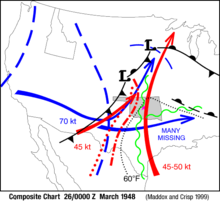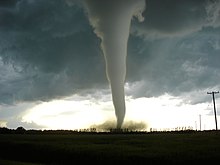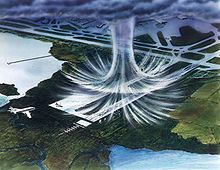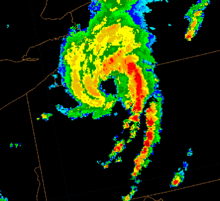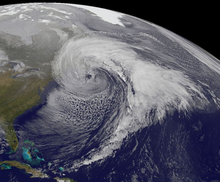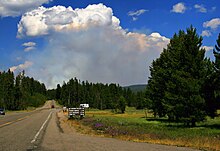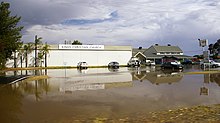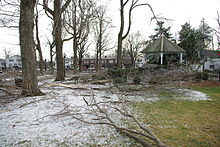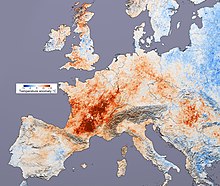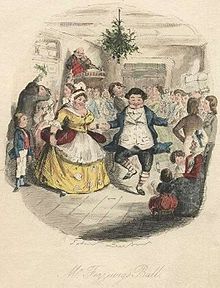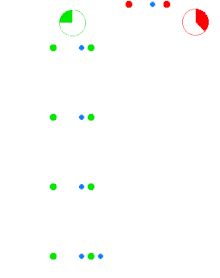Severe weather refers to any dangerous meteorological phenomena with the potential to cause damage, serious social disruption, or loss of human life. Types of severe weather phenomena vary, depending on the latitude, altitude, topography, and atmospheric conditions. High winds, hail, excessive precipitation, and wildfires are forms and effects of severe weather, as are thunderstorms, downbursts, tornadoes, waterspouts, tropical cyclones, and extratropical cyclones. Regional and seasonal severe weather phenomena include blizzards (snowstorms), ice storms, and duststorms.
Terminology
Meteorologists generally define severe weather
as any aspect of the weather that poses risks to life, property or
requires the intervention of authorities. A narrower definition of severe weather is any weather phenomena relating to severe thunderstorms.
According to the World Meteorological Organization (WMO), severe weather can be categorized into two groups: general severe weather and localized severe weather. Nor'easters,
European wind storms, and the phenomena that accompany them form over
wide geographic areas. These occurrences are classified as general severe weather.
Downbursts and tornadoes are more localized and therefore have a more
limited geographic effect. These forms of weather are classified as localized severe weather. The term severe weather is technically not the same phenomenon as extreme weather. Extreme weather describes unusual weather events that are at the extremes of the historical distribution for a given area.
Causes
This graphic shows the conditions favorable for certain organized thunderstorm complexes, based upon CAPE and vertical wind shear values.
Organized severe weather occurs from the same conditions that
generate ordinary thunderstorms: atmospheric moisture, lift (often from thermals), and instability.
A wide variety of conditions cause severe weather. Several factors can
convert thunderstorms into severe weather. For example, a pool of cold
air aloft may aid in the development of large hail from an otherwise
innocuous appearing thunderstorm. However, the most severe hail and
tornadoes are produced by supercell thunderstorms, and the worst downbursts and derechos (straight-line winds) are produced by bow echoes. Both of these types of storms tend to form in environments high in wind shear.
Floods, hurricanes, tornadoes, and thunderstorms are considered to be the most destructive weather-related [develop models to predict the most frequent and possible locations. This information is used to notify affected areas and save lives.
Categories
Diagram
showing ingredients needed for severe weather. The red arrow shows the
position of the low level jet stream, while the blue arrow shows the
location of the upper level jet stream
Severe thunderstorms can be assessed in three different categories.
These are "approaching severe", "severe", and "significantly severe".
Approaching severe is defined as hail between 1⁄2
to 1 inch (13 to 25 mm) diameter or winds between 50 and 58 M.P.H. (50
knots, 80–93 km/h). In the United States, such storms will usually
warrant a Significant Weather Alert.
Severe is defined as hail 1 to 2 inches (25 to 51 mm) diameter, winds 58 to 75 miles per hour (93 to 121 km/h), or an F1 tornado.
Significant severe is defined as hail 2 inches (51 mm) in diameter or larger, winds 75 M.P.H. (65 knots, 120 km/h) or more, or a tornado of strength EF2 or stronger.
Both severe and significant severe events warrant a severe thunderstorm warning from the United States National Weather Service (excludes flash floods), the Environment Canada, the Australian Bureau of Meteorology, or the Meteorological Service of New Zealand if the event occurs in those countries. If a tornado is occurring (a tornado has been seen by spotters) or is imminent (Doppler weather radar has observed strong rotation in a storm, indicating an incipient tornado), the severe thunderstorm warning will be superseded by a tornado warning in the United States and Canada.
A severe weather outbreak is typically considered to be when ten
or more tornadoes, some of which will likely be long-tracked and
violent, and many large hail or damaging wind reports occur
within one or more consecutive days. Severity is also dependent on the
size of the geographic area affected, whether it covers hundreds or
thousands of square kilometers.
High winds
Panorama of a strong shelf cloud, which can precede the onset of high winds
High winds are known to cause damage, depending upon their strength.
Wind speeds as low as 23 knots (43 km/h) may lead to power outages when tree branches fall and disrupt power lines.
Some species of trees are more vulnerable to winds. Trees with shallow
roots are more prone to uproot, and brittle trees such as eucalyptus, sea hibiscus, and avocado are more prone to branch damage.
Wind gusts may cause poorly designed suspension bridges to sway. When wind gusts harmonize with the frequency of the swaying bridge, the bridge may fail as occurred with the Tacoma Narrows Bridge in 1940.
Hurricane-force winds, caused by individual thunderstorms,
thunderstorm complexes, derechos, tornadoes, extratropical cyclones, or
tropical cyclones can destroy mobile homes and structurally damage
buildings with foundations. Winds of this strength due to downslope
winds off terrain have been known to shatter windows and sandblast paint
from cars.
Once winds exceed 135 knots (250 km/h) within strong tropical
cyclones and tornadoes, homes completely collapse, and significant
damage is done to larger buildings. Total destruction to man-made
structures occurs when winds reach 175 knots (324 km/h). The Saffir–Simpson scale for cyclones and Enhanced Fujita scale (TORRO scale in Europe) for tornados were developed to help estimate wind speed from the damage they cause.
Tornado
The F5 tornado that struck Elie, Manitoba, Canada in 2007.
A dangerous rotating column of air in contact with both the surface of the earth and the base of a cumulonimbus cloud (thundercloud) or a cumulus cloud, in rare cases. Tornadoes come in many sizes but typically form a visible condensation funnel whose narrowest end reaches the earth and surrounded by a cloud of debris and dust.
Tornadoes' wind speeds generally average between 40 miles per
hour (64 km/h) and 110 miles per hour (180 km/h). They are approximately
250 feet (76 m) across and travel a few miles (kilometers) before
dissipating. Some attain wind speeds in excess of 300 miles per hour
(480 km/h), may stretch more than two miles (3.2 km) across, and
maintain contact with the ground for dozens of miles (more than 100 km).
Tornadoes, despite being one of the most destructive weather
phenomena, are generally short-lived. A long-lived tornado generally
lasts no more than an hour, but some have been known to last for 2 hours
or longer (for example, the Tri-State Tornado). Due to their relatively short duration, less information is known about the development and formation of tornadoes.
Downburst and derecho
Downbursts are created within thunderstorms by significantly rain-cooled
air, which, upon reaching ground level, spreads out in all directions
and produce strong winds. Unlike winds in a tornado, winds in a downburst are not rotational but are directed outwards from the point where they strike land or water.
Illustration
of a microburst. The air moves in a downward motion until it hits
ground level. It then spreads outward in all directions.
"Dry downbursts" are associated with thunderstorms with very little precipitation, while wet downbursts are generated by thunderstorms with large amounts of rainfall. Microbursts are very small downbursts with winds that extend up to 2.5 miles (4 km) from their source, while macrobursts are large-scale downbursts with winds that extend in excess of 2.5 miles (4 km). The heat burst is created by vertical currents on the backside of old outflow boundaries and squall lines
where rainfall is lacking. Heat bursts generate significantly higher
temperatures due to the lack of rain-cooled air in their formation. Derechos are longer, usually stronger, forms of downburst winds characterized by straight-lined windstorms.
Downbursts create vertical wind shear or microbursts, which are dangerous to aviation. These convective downbursts
can produce damaging winds, lasting 5 to 30 minutes, with wind speeds
as high as 168 mph (75 m/s), and cause tornado-like damage on the
ground. Downbursts also occur much more frequently than tornadoes, with
ten downburst damage reports for every one tornado.
Squall line
Cyclonic vortex over Pennsylvania with a trailing squall line.
A squall line is an elongated line of severe thunderstorms that can form along or ahead of a cold front. The squall line typically contains heavy precipitation, hail, frequent lightning, strong straight line winds, and possibly tornadoes or waterspouts. Severe weather in the form of strong straight-line winds can be expected in areas where the squall line forms a bow echo, in the farthest portion of the bow. Tornadoes can be found along waves within a line echo wave pattern (LEWP) where mesoscale low-pressure areas are present. Intense bow echoes responsible for widespread, extensive wind damage are called derechos, and move quickly over large territories. A wake low
or a mesoscale low-pressure area forms behind the rain shield (a high
pressure system under the rain canopy) of a mature squall line and is
sometimes associated with a heat burst.
Squall lines often cause severe straight-line wind damage, and most non-tornadic wind damage is caused from squall lines. Although the primary danger from squall lines is straight-line winds, some squall lines also contain weak tornadoes.
Tropical cyclone
Hurricane Isabel (2003) as seen from orbit during Expedition 7 of the International Space Station.
Very high winds can be caused by mature tropical cyclones (called hurricanes in the United States and Canada and typhoons in eastern Asia). A tropical cyclone's heavy surf created by such winds may cause harm to marine life either close to or upon the surface of the water, such as coral reefs.
Coastal regions may receive significant damage from a tropical cyclone
while inland regions are relatively safe from the strong winds, due to
their rapid dissipation over land. However, severe flooding can occur
even far inland because of high amounts of rain from tropical cyclones
and their remnants.
Waterspout
Formation of numerous waterspouts in the Great Lakes region.
Waterspouts are generally defined as tornadoes or non-supercell tornadoes that develop over bodies of water.
Waterspouts typically do not do much damage because they occur
over open water, but they are capable of traveling over land.
Vegetation, weakly constructed buildings, and other infrastructure may
be damaged or destroyed by waterspouts. Waterspouts do not generally
last long over terrestrial environments as the friction produced easily
dissipates the winds. Strong horizontal winds disturbe the vortex,
causing waterspouts to dissipate,
While not generally as dangerous as "classic" tornadoes, waterspouts
can overturn boats, and they can cause severe damage to larger ships.
Strong extratropical cyclones
GOES-13 Imagery of an intense Nor'Easter that impacted the North East US on 26 March 2014 and produced recorded gusts of 101mph+
Severe local windstorms in Europe that develop from winds off the
North Atlantic. These windstorms are commonly associated with the
destructive extratropical cyclones and their low pressure frontal
systems. European windstorms occur mainly in the seasons of autumn and winter.
A synoptic-scale extratropical storm along the East Coast of the United States and Atlantic Canada is called a Nor'easter. They are so named because their winds come from the northeast, especially in the coastal areas of the Northeastern United States and Atlantic Canada. More specifically, it describes a low-pressure area whose center of rotation
is just off the East Coast and whose leading winds in the left forward
quadrant rotate onto land from the northeast. Nor'easters may cause
coastal flooding, coastal erosion, and hurricane-force winds.
Dust storm
An unusual form of windstorm that is characterized by the existence
of large quantities of sand and dust particles carried by the wind. Dust storms frequently develop during periods of droughts, or over arid and semi-arid regions.
A massive dust storm cloud (Haboob) is close to enveloping a military camp as it rolls over Al Asad Airbase, Iraq, just before nightfall on 27 April 2005.
Dust storms have numerous hazards and are capable of causing deaths.
Visibility may be reduced dramatically, so risks of vehicle and aircraft
crashes are possible. Additionally, the particulates may reduce oxygen
intake by the lungs, potentially resulting in suffocation. Damage can also be inflicted upon the eyes due to abrasion.
Dust storms can many issues for agricultural industries as well. Soil erosion is one of the most common hazards and decreases arable lands.
Dust and sand particles can cause severe weathering of buildings and
rock formations. Nearby bodies of water may be polluted by settling dust
and sand, killing aquatic organisms. Decrease in exposure to sunlight
can affect plant growth, as well as decrease in infrared radiation may
cause decreased temperatures.
Wildfires
Wildfire in Yellowstone National Park produces a pyrocumulus cloud
The most common cause of wildfires varies throughout the world. In
the United States, Canada, and Northwest China, lightning is the major
source of ignition. In other parts of the world, human involvement is a
major contributor. For instance, in Mexico, Central America, South
America, Africa, Southeast Asia, Fiji, and New Zealand, wildfires can be
attributed to human activities such as animal husbandry, agriculture, and land-conversion burning. Human carelessness is a major cause of wildfires in China and in the Mediterranean Basin.
In Australia, the source of wildfires can be traced to both lightning
strikes and human activities such as machinery sparks and cast-away
cigarette butts." Wildfires have a rapid forward rate of spread (FROS) when burning through dense, uninterrupted fuels. They can move as fast as 10.8 kilometers per hour (6.7 mph) in forests and 22 kilometers per hour (14 mph) in grasslands. Wildfires can advance tangential to the main front to form a flanking front, or burn in the opposite direction of the main front by backing.
Wildfires may also spread by jumping or spotting as winds and vertical convection columns carry firebrands (hot wood embers) and other burning materials through the air over roads, rivers, and other barriers that may otherwise act as firebreaks.
Torching and fires in tree canopies encourage spotting, and dry ground
fuels that surround a wildfire are especially vulnerable to ignition
from firebrands. Spotting can create spot fires
as hot embers and firebrands ignite fuels downwind from the fire. In
Australian bushfires, spot fires are known to occur as far as 10
kilometers (6 mi) from the fire front.
Since the mid-1980s, earlier snowmelt and associated warming has also
been associated with an increase in length and severity of the wildfire
season in the Western United States.
Hail
A large hailstone with concentric rings
Any form of thunderstorm that produces precipitating hailstones is known as a hailstorm. Hailstorms are generally capable of developing in any geographic area where thunderclouds (cumulonimbus) are present, although they are most frequent in tropical and monsoon regions.
The updrafts and downdrafts within cumulonimbus clouds cause water
molecules to freeze and solidify, creating hailstones and other forms of
solid precipitation.
Due to their larger density, these hailstones become heavy enough to
overcome the density of the cloud and fall towards the ground. The
downdrafts in cumulonimbus clouds can also cause increases in the speed
of the falling hailstones. The term "hailstorm" is usually used to
describe the existence of significant quantities or size of hailstones.
Hailstones can cause serious damage, notably to automobiles, aircraft, skylights, glass-roofed structures, livestock, and crops. Rarely, massive hailstones have been known to cause concussions or fatal head trauma.
Hailstorms have been the cause of costly and deadly events throughout
history. One of the earliest recorded incidents occurred around the 12th
century in Wellesbourne, Britain. The largest hailstone in terms of maximum circumference and length ever recorded in the United States fell in 2003 in Aurora, Nebraska, USA. The hailstone had a diameter of 7 inches (18 cm) and a circumference of 18.75 inches (47.6 cm).
Heavy rainfall and flooding
A flash flood caused by a severe thunderstorm
Heavy rainfall can lead to a number of hazards, most of which are
floods or hazards resulting from floods. Flooding is the inundation of
areas that are not normally under water. It is typically divided into
three classes: River flooding, which relates to rivers rising outside
their normals banks; flash flooding, which is the process where a
landscape, often in urban and arid environments, is subjected to rapid
floods; and coastal flooding, which can be caused by strong winds from tropical or non-tropical cyclones. Meteorologically, excessive rains occur within a plume of air with high amounts of moisture (also known as an atmospheric river) which is directed around an upper level cold-core low or a tropical cyclone.
Flash flooding can frequently occur in slow-moving thunderstorms and
are usually caused by the heavy liquid precipitation that accompanies
it. Flash floods are most common in dense populated urban environments,
where less plants and bodies of water are presented to absorb and
contain the extra water. Flash flooding can be hazardous to small
infrastructure, such as bridges, and weakly constructed buildings.
Plants and crops in agricultural areas can be destroyed and devastated
by the force of raging water. Automobiles parked within experiencing
areas can also be displaced. Soil erosion can occur as well, exposing risks of landslide phenomena. Like all forms of flooding phenomenon, flash flooding can also spread and produce waterborne and insect-borne
diseases cause by microorganisms. Flash flooding can be caused by
extensive rainfall released by tropical cyclones of any strength or the
sudden thawing effect of ice dams.
Monsoons
Seasonal wind shifts lead to long-lasting wet seasons which produce the bulk of annual precipitation
in areas such as Southeast Asia, Australia, Western Africa, eastern
South America, Mexico, and the Philippines. Widespread flooding occurs
if rainfall is excessive, which can lead to landslides and mudflows in mountainous areas. Floods cause rivers to exceed their capacity with nearby buildings becoming submerged.
Flooding may be exacerbated if there are fires during the previous dry
season. This may cause soils which are sandy or composed of loam to become hydrophobic and repel water.
Government organizations help their residents deal with wet-season floods though floodplain mapping and information on erosion control. Mapping is conducted to help determine areas that may be more prone to flooding. Erosion control instructions are provided through outreach over the telephone or the internet.
Flood waters that occur during monsoon seasons can often host numerous protozoa, bacterial, and viral microorganisms.
Mosquitoes and flies will lay their eggs within the contaminated bodies
of water. These disease agents may cause infections of foodborne and
waterborne diseases. Diseases associated with exposure to flood waters
include malaria, cholera, typhoid, hepatitis A, and the common cold. Possible trenchfoot infections may also occur when personnel are exposed for extended periods of time within flooded areas.
Tropical cyclone
The damage caused by Hurricane Andrew is a good example of the damage caused by a category 5 Tropical cyclone
A tropical cyclone is a storm system characterized by a low-pressure center and numerous thunderstorms that produce strong winds and flooding rain. A tropical cyclone feeds on heat released when moist air rises, resulting in condensation of water vapor contained in the moist air. Tropical cyclones may produce torrential rain, high waves, and damaging storm surge.
Heavy rains produce significant inland flooding. Storm surges may
produce extensive coastal flooding up to 40 kilometres (25 mi) from the
coastline.
Although cyclones
take an enormous toll in lives and personal property, they are also
important factors in the precipitation regimes of areas they affect.
They bring much-needed precipitation to otherwise dry regions. Areas in their path can receive a year's worth of rainfall from a tropical cyclone passage. Tropical cyclones can also relieve drought conditions. They also carry heat and energy away from the tropics and transport it toward temperate latitudes, which makes them an important part of the global atmospheric circulation mechanism. As a result, tropical cyclones help to maintain equilibrium in the Earth's troposphere.
Severe winter weather
Heavy snowfall
Damage caused by Lake Storm "Aphid" in October 2006
When extratropical cyclones deposit heavy, wet snow with a snow-water
equivalent (SWE) ratio of between 6:1 and 12:1 and a weight in excess
of 10 pounds per square foot (~50 kg/m2)
piles onto trees or electricity lines, significant damage may occur on a
scale usually associated with strong tropical cyclones. An avalanche
can occur with a sudden thermal or mechanical impact on snow that has
accumulated on a mountain, which causes the snow to rush downhill
suddenly. Preceding an avalanche is a phenomenon known as an avalanche
wind caused by the approaching avalanche itself, which adds to its
destructive potential. Large amounts of snow which accumulate on top of man-made structures can lead to structural failure. During snowmelt, acidic precipitation which previously fell in the snow pack is released and harms marine life.
Lake-effect snow is produced in the winter in the shape of one or
more elongated bands. This occurs when cold winds move across long
expanses of warmer lake water, providing energy and picking up water vapor which freezes and is deposited on the lee shores. For more information on this effect see the main article.
Conditions within blizzards often include large quantities of
blowing snow and strong winds which may significantly reduce visibility.
Reduced viability of personnel on foot may result in extended exposure
to the blizzard and increase the chance of becoming lost. The strong
winds associated with blizzards create wind chill that can result in frostbites and hypothermia.
The strong winds present in blizzards are capable of damaging plants
and may cause power outages, frozen pipes, and cut off fuel lines.
Strong extratropical cyclones
The precipitation pattern of Nor'easters is similar to other mature extratropical storms.
Nor'easters can cause heavy rain or snow, either within their
comma-head precipitation pattern or along their trailing cold or
stationary front. Nor'easters can occur at any time of the year but are
mostly known for their presence in the winter season. Severe European windstorms are often characterized by heavy precipitation as well.
Ice storm
Trees that have been destroyed by an ice storm.
Ice storms are also known as a Silver storm, referring to the color of the freezing precipitation. Ice storms are caused by liquid precipitation which freezes upon cold surfaces and leads to the gradual development of a thickening layer of ice.
The accumulations of ice during the storm can be extremely destructive.
Trees and vegetation can be destroyed and in turn may bring down power
lines, causing the loss of heat and communication lines. Roofs of buildings and automobiles may be severely damaged. Gas pipes can become frozen or even damaged causing gas leaks. Avalanches
may develop due to the extra weight of the ice present. Visibility can
be reduced dramatically. The aftermath of an ice storm may result in
severe flooding due to sudden thawing, with large quantities of
displaced water, especially near lakes, rivers, and bodies of water.
Heat and drought
Drought
Crops in Australia that have failed due to drought conditions.
Another form of severe weather is drought, which is a prolonged
period of persistently dry weather (that is, absence of precipitation). Although droughts do not develop or progress as quickly as other forms of severe weather, their effects can be just as deadly; in fact, droughts are classified and measured based upon these effects. Droughts have a variety of severe effects; they can cause crops to fail, and they can severely deplete water resources, sometimes interfering with human life. A drought in the 1930s known as the Dust Bowl affected 50 million acres of farmland in the central United States.
In economic terms, they can cost many billions of dollars: a drought in
the United States in 1988 caused over $40 billion in losses, exceeding the economic totals of Hurricane Andrew, the Great Flood of 1993, and the 1989 Loma Prieta earthquake.
In addition to the other severe effects, the dry conditions caused by
droughts also significantly increase the risk of wildfires.
Heat waves
A map indicating above-normal temperatures in Europe in 2003
Although official definitions vary, a heat wave is generally defined as a prolonged period with excessive heat.
Although heat waves do not cause as much economic damage as other types
of severe weather, they are extremely dangerous to humans and animals:
according to the United States National Weather Service, the average
total number of heat-related fatalities each year is higher than the
combined total fatalities for floods, tornadoes, lightning strikes, and
hurricanes. In Australia, heat waves cause more fatalities than any other type of severe weather.
As in droughts, plants can also be severely affected by heat waves
(which are often accompanied by dry conditions) can cause plants to lose
their moisture and die. Heat waves are often more severe when combined with high humidity.


